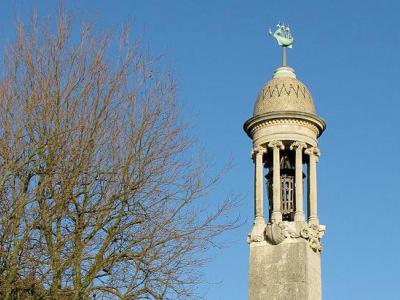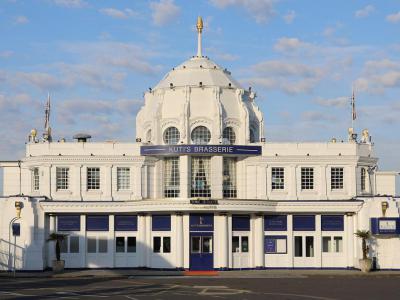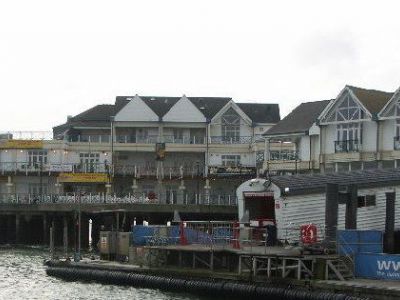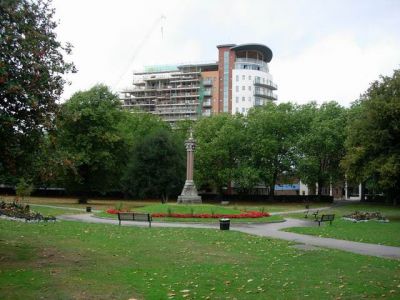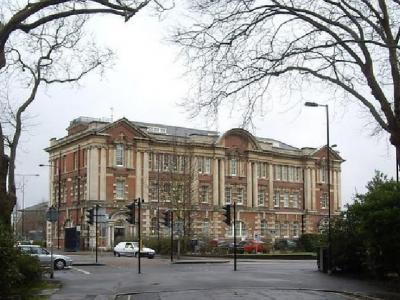
Southampton Waterfront Walk (Self Guided), Southampton
A major seaport on the south coast of England, the city of Southampton abounds in attractions of various sorts. Southampton Waterfront, in particular, holds significant historical and cultural value, offering ample opportunities for sightseeing, shopping, dining, recreation, and entertainment.
At the heart of this vibrant area is the Pilgrims Fathers Memorial, commemorating the departure of the Mayflower ship in 1620, an event significant in American history. Nearby, the iconic Royal Pier stands as a symbol of Southampton's seafaring legacy, whereas the adjacent Mayflower Park provides a picturesque setting for strolls and family gatherings.
Town Quay, where ferries and cruise ships dock, serves as a bustling hub for marine activities. Flanking it Queens Park Terrace adds a touch of elegance with its Victorian architecture. In turn, the Admiralty House, with its distinctive appearance, reminds us of Southampton's nautical importance – once serving as the headquarters of the Admiralty Charts and Publications department.
South Western House, a historic landmark, reflects the city's architectural heritage, while Solent Sky provides a fascinating insight into Southampton's aviation history with its collection of vintage aircraft.
In contrast to the above, Ocean Village completes the waterfront experience with its modern marina, trendy restaurants, and vibrant atmosphere, drawing locals and tourists alike.
Whether you're interested in delving into the city's maritime past, enjoying a leisurely stroll along the quayside, or indulging in waterfront dining, Southampton invites you to discover its captivating waterfront and create lasting memories by the sea. So plan your visit today and explore the charms of Southampton Waterfront firsthand with the help of this self-guided walk!
At the heart of this vibrant area is the Pilgrims Fathers Memorial, commemorating the departure of the Mayflower ship in 1620, an event significant in American history. Nearby, the iconic Royal Pier stands as a symbol of Southampton's seafaring legacy, whereas the adjacent Mayflower Park provides a picturesque setting for strolls and family gatherings.
Town Quay, where ferries and cruise ships dock, serves as a bustling hub for marine activities. Flanking it Queens Park Terrace adds a touch of elegance with its Victorian architecture. In turn, the Admiralty House, with its distinctive appearance, reminds us of Southampton's nautical importance – once serving as the headquarters of the Admiralty Charts and Publications department.
South Western House, a historic landmark, reflects the city's architectural heritage, while Solent Sky provides a fascinating insight into Southampton's aviation history with its collection of vintage aircraft.
In contrast to the above, Ocean Village completes the waterfront experience with its modern marina, trendy restaurants, and vibrant atmosphere, drawing locals and tourists alike.
Whether you're interested in delving into the city's maritime past, enjoying a leisurely stroll along the quayside, or indulging in waterfront dining, Southampton invites you to discover its captivating waterfront and create lasting memories by the sea. So plan your visit today and explore the charms of Southampton Waterfront firsthand with the help of this self-guided walk!
How it works: Download the app "GPSmyCity: Walks in 1K+ Cities" from Apple App Store or Google Play Store to your mobile phone or tablet. The app turns your mobile device into a personal tour guide and its built-in GPS navigation functions guide you from one tour stop to next. The app works offline, so no data plan is needed when traveling abroad.
Southampton Waterfront Walk Map
Guide Name: Southampton Waterfront Walk
Guide Location: England » Southampton (See other walking tours in Southampton)
Guide Type: Self-guided Walking Tour (Sightseeing)
# of Attractions: 9
Tour Duration: 1 Hour(s)
Travel Distance: 2.1 Km or 1.3 Miles
Author: Maia
Sight(s) Featured in This Guide:
Guide Location: England » Southampton (See other walking tours in Southampton)
Guide Type: Self-guided Walking Tour (Sightseeing)
# of Attractions: 9
Tour Duration: 1 Hour(s)
Travel Distance: 2.1 Km or 1.3 Miles
Author: Maia
Sight(s) Featured in This Guide:
- Pilgrims Fathers Memorial
- Royal Pier
- Mayflower Park
- Town Quay
- Queens Park Terrace
- Admiralty House
- South Western House
- Solent Sky
- Ocean Village
1) Pilgrims Fathers Memorial
The Pilgrim Fathers Memorial in Southampton commemorates a pivotal moment in the journey of the Pilgrims who sought religious freedom. Built in 1913, this monument marks the departure of the "Mayflower" and "Speedwell" ships from Southampton Quay in 1620, carrying the Pilgrim Fathers to America. Fleeing persecution under the reign of King James I, the Pilgrims were driven by their desire to practice their Puritan faith freely.
The memorial, located on the north bank of The Haven, near the former site of Scotia Creek in Fishtoft, Lincolnshire, also recognizes earlier efforts by the Scrooby Congregation. These English Separatist Protestants first attempted to flee England in 1607, chartering a Dutch vessel to transport them to the Netherlands. However, their plan was thwarted when the captain betrayed them, leading to their arrest and imprisonment. A year later, they succeeded in their escape, first arriving in Amsterdam before settling in Leiden in 1609. By 1620, the congregation set sail for the New World, departing from Southampton and Plymouth.
Erected by the former Boston Borough Council in 1957 on the 350th anniversary of the Scrooby Congregation's journey, the memorial is a small granite obelisk mounted on a granite block. Designed to symbolize the determination and faith of the Pilgrims, the monument was crafted by Leake's Masonry and attended by members of the General Society of Mayflower Descendants. The tapering shaft represents the steadfastness and resilience of the men and women who left their homeland in pursuit of religious liberty.
The memorial, located on the north bank of The Haven, near the former site of Scotia Creek in Fishtoft, Lincolnshire, also recognizes earlier efforts by the Scrooby Congregation. These English Separatist Protestants first attempted to flee England in 1607, chartering a Dutch vessel to transport them to the Netherlands. However, their plan was thwarted when the captain betrayed them, leading to their arrest and imprisonment. A year later, they succeeded in their escape, first arriving in Amsterdam before settling in Leiden in 1609. By 1620, the congregation set sail for the New World, departing from Southampton and Plymouth.
Erected by the former Boston Borough Council in 1957 on the 350th anniversary of the Scrooby Congregation's journey, the memorial is a small granite obelisk mounted on a granite block. Designed to symbolize the determination and faith of the Pilgrims, the monument was crafted by Leake's Masonry and attended by members of the General Society of Mayflower Descendants. The tapering shaft represents the steadfastness and resilience of the men and women who left their homeland in pursuit of religious liberty.
2) Royal Pier
The Royal Pier officially opened in 1833. Princess Victoria (later Queen Victoria) opened the pier. In 1864, a pontoon was added. In 1871, railway lines reached the pier. The pier underwent a significant renovation in 1892. A pavilion was added in 1894 and hosted events such as concerts, plays, dances, and roller-skating.
The pier and railway deteriorated during WWI when the trains did not run. Train service ended in 1921, but ferries continued to operate.
Throughout the years, the pier has fallen into disrepair and is now derelict. Many plans have been proposed to develop the pier have been considered, some including a casino and hotel. However, the plans have never moved forward.
Today, visitors can enjoy the Royal Pier Gate House, which hosts a restaurant. Visitors can enjoy an outdoor dining area and watch boats go by.
The pier and railway deteriorated during WWI when the trains did not run. Train service ended in 1921, but ferries continued to operate.
Throughout the years, the pier has fallen into disrepair and is now derelict. Many plans have been proposed to develop the pier have been considered, some including a casino and hotel. However, the plans have never moved forward.
Today, visitors can enjoy the Royal Pier Gate House, which hosts a restaurant. Visitors can enjoy an outdoor dining area and watch boats go by.
3) Mayflower Park
Mayflower Park in Southampton is a historically significant riverside park located on the banks of the River Test. Constructed in the 1930s by reclaiming surrounding mudflats, the park was initially known as the Royal Recreation Ground until 1955, when it was refurbished and renamed after the famous vessel, the Mayflower. This waterfront park remains a favorite location for the naming and christening of ships, as well as a popular venue for events like the Southampton Boat Show.
The park offers scenic views of the River Test and its maritime traffic, making it an essential recreational space for residents and visitors alike. As Southampton’s only city-centre waterside park, Mayflower Park provides a peaceful spot to watch ships—such as the Queen Mary II—departing from the adjacent port. Its central location makes it especially valuable for those living in nearby estates or staying in local hotels.
In addition to boat shows, the park hosts various events, including music concerts, circuses, and fireworks displays. Visitors can also enjoy the children’s playground, multi-use sports fields, and a café. Mayflower Park’s tranquil atmosphere, with benches overlooking the river, makes it a great spot for picnics, meditation, or simply watching the world go by.
Located near Southampton Port, the park is easily accessible on foot from Southampton Central Railway Station or by car, with parking available on-site. Visitors can also explore nearby attractions such as the Quilter’s Vault and the Medieval Merchant’s House, making it an ideal spot to unwind while soaking in the maritime heritage of the city.
The park offers scenic views of the River Test and its maritime traffic, making it an essential recreational space for residents and visitors alike. As Southampton’s only city-centre waterside park, Mayflower Park provides a peaceful spot to watch ships—such as the Queen Mary II—departing from the adjacent port. Its central location makes it especially valuable for those living in nearby estates or staying in local hotels.
In addition to boat shows, the park hosts various events, including music concerts, circuses, and fireworks displays. Visitors can also enjoy the children’s playground, multi-use sports fields, and a café. Mayflower Park’s tranquil atmosphere, with benches overlooking the river, makes it a great spot for picnics, meditation, or simply watching the world go by.
Located near Southampton Port, the park is easily accessible on foot from Southampton Central Railway Station or by car, with parking available on-site. Visitors can also explore nearby attractions such as the Quilter’s Vault and the Medieval Merchant’s House, making it an ideal spot to unwind while soaking in the maritime heritage of the city.
4) Town Quay
Town Quay in Southampton has a rich history that dates back to its earliest mention in 1411 when it was known as Watergate Quay. The quay underwent major transformations in the 19th century, with the modern Town Quay taking shape in the early 1800s. A key development in 1871 was the introduction of a horse-drawn tramway, connecting the quay to the railway, which was later upgraded to light locomotives in 1876. During World War I, the quay played a crucial role in military logistics, seeing extensive use by military barges.
By the 1930s, commercial traffic had shifted to other locations, leaving Town Quay to handle more passenger services, a trend that continues today. The quay is now home to a bustling marina, and both the Hythe Ferry and the Red Funnel high-speed services operate from here. The quay retains historical significance through buildings like the Geddes Warehouse, which has been repurposed into a boutique hotel and restaurant, and the Harbor Board Office, a structure from the 1920s that still stands.
Town Quay also serves as a commercial hub, housing waterside offices for a variety of businesses, including tech companies, marine enterprises, and consultants. The quay continues to evolve while maintaining its historical charm, with a Grade II listed status on key buildings and modern conveniences that cater to both business and leisure.
By the 1930s, commercial traffic had shifted to other locations, leaving Town Quay to handle more passenger services, a trend that continues today. The quay is now home to a bustling marina, and both the Hythe Ferry and the Red Funnel high-speed services operate from here. The quay retains historical significance through buildings like the Geddes Warehouse, which has been repurposed into a boutique hotel and restaurant, and the Harbor Board Office, a structure from the 1920s that still stands.
Town Quay also serves as a commercial hub, housing waterside offices for a variety of businesses, including tech companies, marine enterprises, and consultants. The quay continues to evolve while maintaining its historical charm, with a Grade II listed status on key buildings and modern conveniences that cater to both business and leisure.
5) Queens Park Terrace
Queens Park Terrace in Southampton is a charming green space nestled in the heart of the city, offering visitors a peaceful escape from the bustling urban environment. Surrounded by majestic London Plane trees, which transform with the seasons, the park provides a scenic backdrop for leisurely walks or relaxed picnics.
A key feature of the park is the General Gordon Memorial, honoring the 19th-century British Army officer known for his role in the Crimean War and his service in China. This military monument adds a historical dimension to the park's serene atmosphere. Not far from the memorial, visitors can discover a unique artistic landmark—Reece Ingram’s Organism No.1, a sculpture created in 1996 from the trunk of a beloved London Plane tree that once stood proudly in the park.
As you stroll through the park's well-kept paths, you’ll find the calming sight of daffodils, manicured lawns, and glimpses of ships at the nearby Southampton Docks. Queens Park also holds historical significance, with sketches and photos showing families enjoying the park as far back as the 18th century.
Queens Park is conveniently located near other key attractions, including the Mayflower Park, Solent Sky Museum, and the Old City Walls, making it a perfect spot to relax between sightseeing. Accessible by numerous bus routes, the park also lies near Oxford Street, where you can end your day with dinner at one of the international restaurants.
A key feature of the park is the General Gordon Memorial, honoring the 19th-century British Army officer known for his role in the Crimean War and his service in China. This military monument adds a historical dimension to the park's serene atmosphere. Not far from the memorial, visitors can discover a unique artistic landmark—Reece Ingram’s Organism No.1, a sculpture created in 1996 from the trunk of a beloved London Plane tree that once stood proudly in the park.
As you stroll through the park's well-kept paths, you’ll find the calming sight of daffodils, manicured lawns, and glimpses of ships at the nearby Southampton Docks. Queens Park also holds historical significance, with sketches and photos showing families enjoying the park as far back as the 18th century.
Queens Park is conveniently located near other key attractions, including the Mayflower Park, Solent Sky Museum, and the Old City Walls, making it a perfect spot to relax between sightseeing. Accessible by numerous bus routes, the park also lies near Oxford Street, where you can end your day with dinner at one of the international restaurants.
6) Admiralty House
Admiralty House, located on Canute Road in Southampton, is a prominent three-story red-brick building originally constructed around 1902. Designed in the Rennaissance style, it served as the main post office and telegraph office for the Southampton docks, facilitating mail handling for the great ocean liners. The building opened around 1905 and played a key role in the operation of the docks, with mail being sorted here before being loaded onto ships.
Admiralty House is notable for its distinctive architectural features, including a hipped slate roof, stone dressings, and a central projecting section with a curved open pediment supported by Tuscan columns and pilasters. The sash windows and round-headed arches with keystones further enhance its historic charm. The structure was later used by British Telecom before being converted into apartments in 1999.
Now Grade II listed, Admiralty House retains its historical character while offering modern living spaces. The apartments feature high ceilings, large bay windows, and modern amenities, creating a blend of classic and contemporary styles. Its location near Oxford Street and the city center ensures easy access to local transport links and Southampton’s vibrant community.
Admiralty House is notable for its distinctive architectural features, including a hipped slate roof, stone dressings, and a central projecting section with a curved open pediment supported by Tuscan columns and pilasters. The sash windows and round-headed arches with keystones further enhance its historic charm. The structure was later used by British Telecom before being converted into apartments in 1999.
Now Grade II listed, Admiralty House retains its historical character while offering modern living spaces. The apartments feature high ceilings, large bay windows, and modern amenities, creating a blend of classic and contemporary styles. Its location near Oxford Street and the city center ensures easy access to local transport links and Southampton’s vibrant community.
7) South Western House
South Western House, originally opened as the Imperial Hotel in 1865, stands as a key landmark in Southampton, reflecting both historical grandeur and modern luxury. Designed by John Norton in the French Renaissance style, the building once earned the moniker “The Ritz of Southampton.” It catered to an elite clientele, including Titanic's first-class passengers, who stayed there the night before embarking on their ill-fated voyage in 1912.
The hotel’s architecture, with its marble walls, grand staircase, and ceiling murals, encapsulated the opulence of the late 19th and early 20th centuries. It served as a hub for the rich and famous, hosting figures like Winston Churchill and Dwight Eisenhower, who used the venue to plan the D-Day invasion during World War II. Hollywood icons such as Laurel and Hardy, Charlie Chaplin, and Amelia Earhart also walked its halls, adding to its illustrious history.
Although the Second World War saw the building taken over by the Royal Navy as HMS Shrapnel, the South Western House continued to evolve. Its rich history has been preserved through its Grade II listing, and the building has been carefully redeveloped into luxury apartments and penthouses. The ground floor maintains its connection to the past, with features like the original marble pillars still intact, reminding visitors of its former grandeur.
Today, South Western House blends its historic charm with modern amenities, offering a glimpse into Southampton’s luxurious past while continuing to be a vibrant part of the city.
The hotel’s architecture, with its marble walls, grand staircase, and ceiling murals, encapsulated the opulence of the late 19th and early 20th centuries. It served as a hub for the rich and famous, hosting figures like Winston Churchill and Dwight Eisenhower, who used the venue to plan the D-Day invasion during World War II. Hollywood icons such as Laurel and Hardy, Charlie Chaplin, and Amelia Earhart also walked its halls, adding to its illustrious history.
Although the Second World War saw the building taken over by the Royal Navy as HMS Shrapnel, the South Western House continued to evolve. Its rich history has been preserved through its Grade II listing, and the building has been carefully redeveloped into luxury apartments and penthouses. The ground floor maintains its connection to the past, with features like the original marble pillars still intact, reminding visitors of its former grandeur.
Today, South Western House blends its historic charm with modern amenities, offering a glimpse into Southampton’s luxurious past while continuing to be a vibrant part of the city.
8) Solent Sky (must see)
Solent Sky, formerly known as the Southampton Hall of Aviation, is a fascinating aviation museum located in Southampton. The museum is dedicated to showcasing the rich history of aviation in Southampton, the Solent area, and Hampshire, with a particular emphasis on the legendary Supermarine aircraft company, which was based in Woolston, Southampton. Supermarine's most iconic creations, including the Supermarine S.6 seaplane and the renowned Supermarine Spitfire, designed under the leadership of R. J. Mitchell, take center stage in the exhibits.
Solent Sky also delves into the thrilling Schneider Trophy seaplane races, which were held twice at Calshot Spit, and features displays on the flying boat services that once operated from the Solent. One of the museum’s standout exhibits is the Short Sandringham flying boat, which visitors can walk through. The museum traces its roots back to the 1970s when a smaller museum dedicated to Supermarine was housed in a NAAFI hut on Havelock Road. By 1984, the museum had relocated to its current purpose-built location, designed by Barry Eaton, Southampton’s City Architect.
In addition to the Spitfire and seaplanes, Solent Sky houses an impressive collection of more than 20 aircraft from the golden age of aviation, ranging from the Gnat jet to the AVRO 504J replica. The museum also hosts an archive of wartime memorabilia, military uniforms, and exhibits related to Hampshire’s rich aviation heritage. Visitors can engage with the collection by sitting in jet fighter cockpits or learning about Southampton’s role as the home to the world’s largest flying boat operation.
Solent Sky recently incorporated the Hampshire Police and Fire Heritage Trust Exhibition, adding another layer of history by illustrating the development of the region's police and fire services. With its dynamic displays, including interactive experiences and an array of historical artifacts, Solent Sky offers an immersive journey into the heart of British aviation history.
The museum is open to visitors year-round, though it remains closed on Mondays, except for school and bank holidays.
Solent Sky also delves into the thrilling Schneider Trophy seaplane races, which were held twice at Calshot Spit, and features displays on the flying boat services that once operated from the Solent. One of the museum’s standout exhibits is the Short Sandringham flying boat, which visitors can walk through. The museum traces its roots back to the 1970s when a smaller museum dedicated to Supermarine was housed in a NAAFI hut on Havelock Road. By 1984, the museum had relocated to its current purpose-built location, designed by Barry Eaton, Southampton’s City Architect.
In addition to the Spitfire and seaplanes, Solent Sky houses an impressive collection of more than 20 aircraft from the golden age of aviation, ranging from the Gnat jet to the AVRO 504J replica. The museum also hosts an archive of wartime memorabilia, military uniforms, and exhibits related to Hampshire’s rich aviation heritage. Visitors can engage with the collection by sitting in jet fighter cockpits or learning about Southampton’s role as the home to the world’s largest flying boat operation.
Solent Sky recently incorporated the Hampshire Police and Fire Heritage Trust Exhibition, adding another layer of history by illustrating the development of the region's police and fire services. With its dynamic displays, including interactive experiences and an array of historical artifacts, Solent Sky offers an immersive journey into the heart of British aviation history.
The museum is open to visitors year-round, though it remains closed on Mondays, except for school and bank holidays.
9) Ocean Village (must see)
Ocean Village in Southampton, located at the mouth of the River Itchen, is a vibrant mixed-use development that combines residential, business, and leisure facilities. Originally the site of Southampton's first working docks, the "Outer Dock," which opened in 1842, the area was redeveloped into a marina in 1986. Today, Ocean Village offers a lively atmosphere with a cinema, cafes, wine bars, and restaurants.
The marina, managed by Marina Developments Limited (MDL), boasts 375 berths and can accommodate tall ships and large yachts. It has hosted several major yacht races, including the Global Challenge (1992, 1996, and 2000) and the Clipper Round the World Yacht Race in 2011. While it was once home to the Royal Southampton Yacht Club until 2018, it continues to attract maritime enthusiasts and businesses, with offices for companies like PricewaterhouseCoopers housed in its complex.
A historical highlight is Enterprise House, a former dock warehouse now repurposed into serviced offices. Between 1988 and 2010, the LV 78 Calshot Spit lightvessel, a historic lightship built in 1914, was stationed at the marina as a static attraction. The lightship was later moved for restoration and now resides at the Solent Sky Museum.
Ocean Village, with its rich history and ongoing developments, continues to be a key part of Southampton's maritime and social landscape.
The marina, managed by Marina Developments Limited (MDL), boasts 375 berths and can accommodate tall ships and large yachts. It has hosted several major yacht races, including the Global Challenge (1992, 1996, and 2000) and the Clipper Round the World Yacht Race in 2011. While it was once home to the Royal Southampton Yacht Club until 2018, it continues to attract maritime enthusiasts and businesses, with offices for companies like PricewaterhouseCoopers housed in its complex.
A historical highlight is Enterprise House, a former dock warehouse now repurposed into serviced offices. Between 1988 and 2010, the LV 78 Calshot Spit lightvessel, a historic lightship built in 1914, was stationed at the marina as a static attraction. The lightship was later moved for restoration and now resides at the Solent Sky Museum.
Ocean Village, with its rich history and ongoing developments, continues to be a key part of Southampton's maritime and social landscape.
Walking Tours in Southampton, England
Create Your Own Walk in Southampton
Creating your own self-guided walk in Southampton is easy and fun. Choose the city attractions that you want to see and a walk route map will be created just for you. You can even set your hotel as the start point of the walk.
Southampton Introduction Walking Tour
Southampton is an important port city with a long history. Archaeological records indicate that the area has been settled since the Stone Age. The Romans had a settlement here, and the Anglo-Saxons later settled in the area.
Southampton became a major port after the 1066 Norman Conquest. Southampton's impressive walls were built following a French incursion in the 1300s.
The Mayflower... view more
Tour Duration: 2 Hour(s)
Travel Distance: 3.3 Km or 2.1 Miles
Southampton became a major port after the 1066 Norman Conquest. Southampton's impressive walls were built following a French incursion in the 1300s.
The Mayflower... view more
Tour Duration: 2 Hour(s)
Travel Distance: 3.3 Km or 2.1 Miles
Titanic Tour in Southampton
Over a hundred years since the sinking of Titanic, the echo of that tragedy still reverberates throughout Southampton. Indeed, nowhere else was the pain of the Titanic disaster, one of the deadliest in maritime history, felt more intensely than here. The majority of Titanic's 900-strong crew were from Southampton, of whom only a handful returned home. More than 500 local households overnight... view more
Tour Duration: 2 Hour(s)
Travel Distance: 3.9 Km or 2.4 Miles
Tour Duration: 2 Hour(s)
Travel Distance: 3.9 Km or 2.4 Miles
Southampton Old Town Walking Tour
Southampton is a bustling coastal city with the history going back all the way to the Stone Age. There are over 90 listed buildings and 30 ancient monuments in the Old Town, including medieval watch towers and dungeons, an array of churches, fine timber-framed Tudor houses, inns and hole-in-the-wall pubs. Despite heavy bombardment during WWII, much of Southampton's historic heritage survived... view more
Tour Duration: 2 Hour(s)
Travel Distance: 1.9 Km or 1.2 Miles
Tour Duration: 2 Hour(s)
Travel Distance: 1.9 Km or 1.2 Miles
The Most Popular Cities
/ view all
